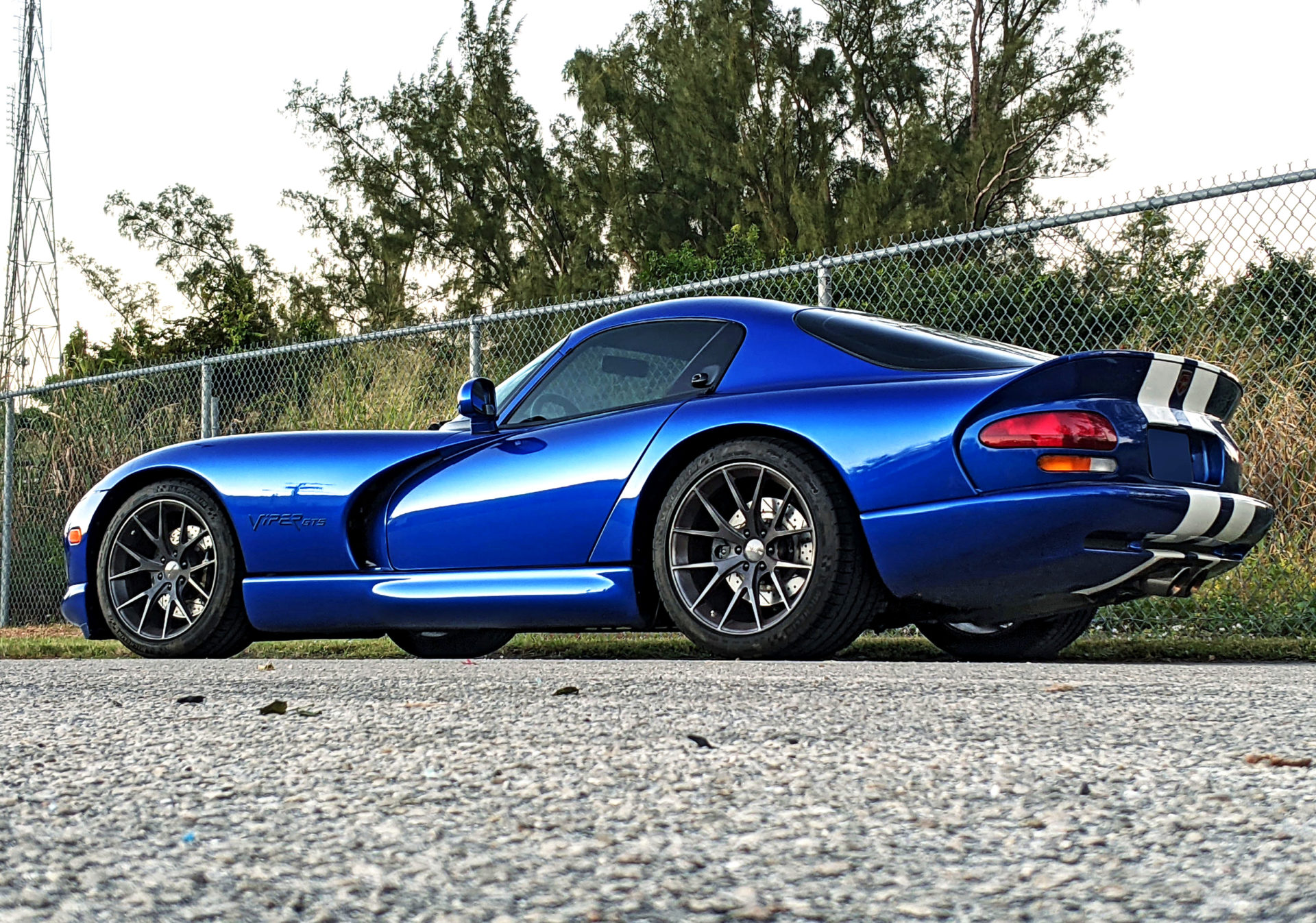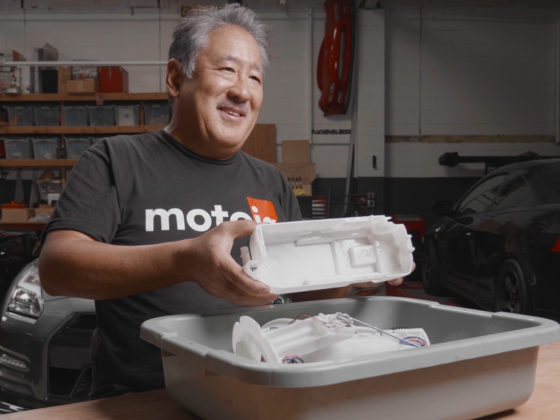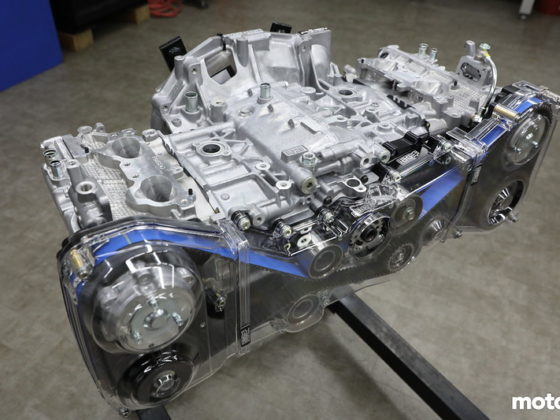 Out back, the old 345/30-19 PS2 “C1” tire has a lot more, smaller, lateral features than those found on the PSS. If you look at the far-right edge of the tire, you can see the excessive shoulder wear from the previous track test, indicating that the car needed more static camber when it was tracked. The new PSS is the same size as the old PS2.
Out back, the old 345/30-19 PS2 “C1” tire has a lot more, smaller, lateral features than those found on the PSS. If you look at the far-right edge of the tire, you can see the excessive shoulder wear from the previous track test, indicating that the car needed more static camber when it was tracked. The new PSS is the same size as the old PS2.
 All mounted up, the front 285/35-18 PSS tire frames the beautiful Forgeline VX1-6 wheels. This monoblock wheel is far cleaner, modern, and stiffer than the previous old 3-piece wheel. The narrow spoke design allows for a far better view of the brakes. At 13 inches in diameter, those will need to be upgraded in the future.
All mounted up, the front 285/35-18 PSS tire frames the beautiful Forgeline VX1-6 wheels. This monoblock wheel is far cleaner, modern, and stiffer than the previous old 3-piece wheel. The narrow spoke design allows for a far better view of the brakes. At 13 inches in diameter, those will need to be upgraded in the future.
 Out back, the 345/30-19 wheels look great and help even out the spacing from the tire to the massive fender well, and the tire to the 13-inch rear brakes with a tiny Lotus Elise rear caliper, which we upgraded in Part 15.
Out back, the 345/30-19 wheels look great and help even out the spacing from the tire to the massive fender well, and the tire to the 13-inch rear brakes with a tiny Lotus Elise rear caliper, which we upgraded in Part 15.
 The transparent smoke finish of the VX1-6 wheels really compliments the blue of the car. I’m not usually a fan of bright silver or chrome wheels, and black loses a lot of a wheel’s character, so this finish is a nice balance that shows off the design well and still looks great when there’s some brake dust.
The transparent smoke finish of the VX1-6 wheels really compliments the blue of the car. I’m not usually a fan of bright silver or chrome wheels, and black loses a lot of a wheel’s character, so this finish is a nice balance that shows off the design well and still looks great when there’s some brake dust.
 From a ¾ view, the dimension of these sharp spokes really starts to pop visually. The concave spokes really add a lot of character and modern aggression to the car.
From a ¾ view, the dimension of these sharp spokes really starts to pop visually. The concave spokes really add a lot of character and modern aggression to the car.
 On the street, these Michelin Pilot Super Sport tires were fantastic. Michelin is a benchmark for a reason and there’s no surprise why most supercars and sportscars out on the market use these tires. For a street-driven performance car, it’s hard to beat the balance of performance, comfort, and quality of Michelin.
On the street, these Michelin Pilot Super Sport tires were fantastic. Michelin is a benchmark for a reason and there’s no surprise why most supercars and sportscars out on the market use these tires. For a street-driven performance car, it’s hard to beat the balance of performance, comfort, and quality of Michelin.
Our Viper rides so well and is quiet without the drone that is caused by many track-focused tires. The ride quality of the old bespoke Viper “C1” PS2 tires was also great, but the newer materials and technology in the PSS just makes the tire that much better.
 Overall, we love the new look that the Forgeline VX1-6 wheel has brought to our 1997 Viper. The Michelin Pilot Super Sport tires are fantastic on the street, but that is not really a surprise. It’s important to realize that this PSS isn’t obsolete with the introduction of the PS4S, but rather it’s role is slightly more focused towards longevity. Michelin still produces both the PSS and PS4S.
Overall, we love the new look that the Forgeline VX1-6 wheel has brought to our 1997 Viper. The Michelin Pilot Super Sport tires are fantastic on the street, but that is not really a surprise. It’s important to realize that this PSS isn’t obsolete with the introduction of the PS4S, but rather it’s role is slightly more focused towards longevity. Michelin still produces both the PSS and PS4S.
Now that the road manners of our car are excellent, we are now ready to take it to the track to see how everything we have done up to this point comes together. I’m really interested to see how this off-the-shelf tire, that’s nearly a decade newer stacks up on track against a 2003-spec, bespoke PS2 “C1” tire designed for the Viper with far more aggressive compounding. We will be hitting the track next with data to answer all of these questions. Stay tuned!




9 comments
gorgeous wheels and tires. not sure if i missed it being mentioned in the article, but why didn’t you go with the PS4? I love the michelin feel when they are new, but they age and crack SO fast, even in a garaged car in Los Angeles. They dry rot and plasticize within 5 years easily. I know its recommended to get new tires every 6 years or whatever, but its a bit dramatic with Michelin from the sets I’ve interacted with.
The PS4S was not available in the Viper size at the time of the install. The previous “C1” Viper compound was well over 5 years old and did not have dry rot issues, neither have a lot of the PS2 or PSS tires that i’ve personally used.
Damn, so much tread left on that old tire. Do you even drive this car?
It’s not always the wear but the age of the tire that matters. The tires were old and needed replacing; plus the tread was down to the wear marks and the outer shoulders were worn completely; close to cords, and would not last much longer on track.
Yeah, because we know what happens when a Viper get a blowout at high speed…
Hey, great DIY writeup. Thanks. Are you going to continue on that project any further?
So much left 😉 brake distribution, steering cooler, track testing … what about a carbon drive shaft and other cool stuff to bring that thing back into competition to today’s cars?!
Hey! I’ve just finished reading all the 16 parts of your Viper story and I must say I’m really impressed with the quality of material (all the measurements before-after and etc). Keep it up! Can’t wait to read the next parts.
Thank you for the kind words!
I just bought a 2002 RT/10, and I have greatly enjoyed these articles, especially with how you reference all years of the 2nd gen cars, so the information is very relevant to me. I also have a set of VX1’s on my car. The previous owner set it up for track use, which I won’t be doing regularly myself. I look forward to seeing how you upgrade the brakes! Will you invest in headers or any additional work to the motor? I would love to upgrade my cam to get that lumpy 708 idle.